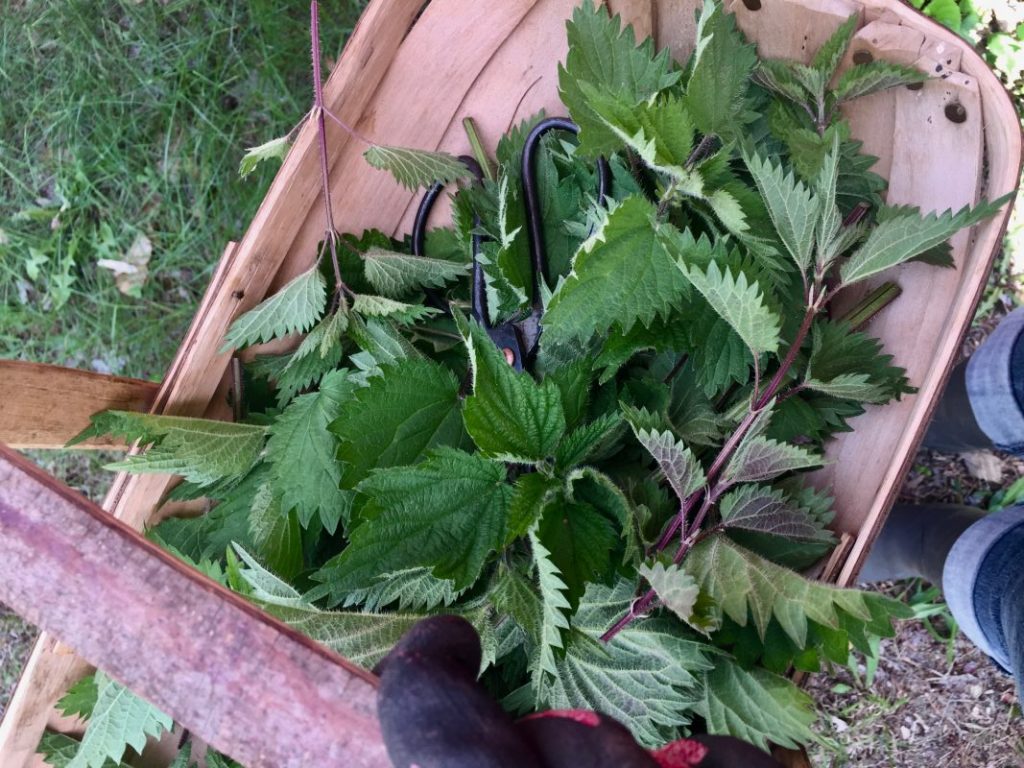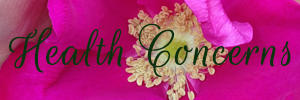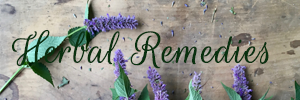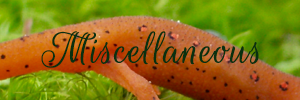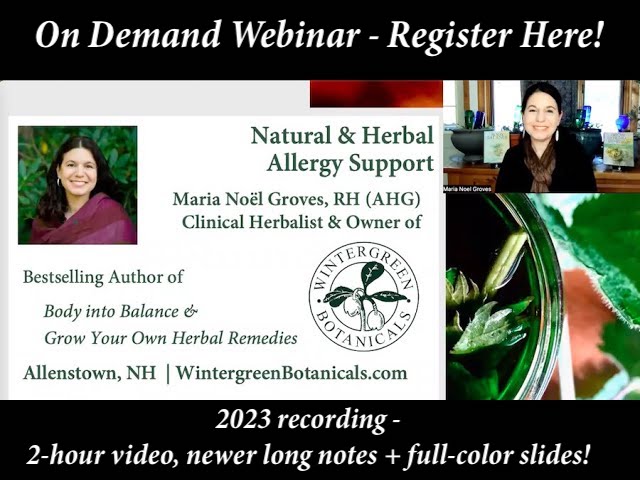
We may see the natural world as a major cause of allergies, but it can also be a source for relief. Several herbs and foods have antihistamine effects. You can reduce or eliminate your seasonal allergies by taking a few natural remedies and tweaking your lifestyle and diet. You don’t have to turn to Claritin. I promise. Here’s how…
Allergies 101
Your basic allergic response begins with an allergen, such as pollen. Once the allergen enters your body, it encounters a type of white blood cell called a B lymphocyte. The B cell produces antibodies, which recognize the allergen and also contain immunoglobulin (Ig). IgE is most often involved in allergic reactions. The antibodies grab onto the allergen, which attract other immune cells including mast cells. The mast cells release histamine, which causes your allergy symptoms: tissue inflammation, sneezing, itching, swelling, watery eyes, etc. From your body’s point of view, the histamine response controls any possible infection, eliminates the allergen through runny noses, etc, and activates immune cells to fight the perceived infection.
Unfortunately, our bodies often become allergic to substances that would normally do little or no harm. Pollen, pet dander, peanuts, and dust are not inherently bad; however, our bodies may mark them as dangerous and produce antibodies for them. Two major things can determine your allergic reaction: 1. the intensity of exposure to one or more allergens, and 2. the health of your immune system. Several experts also believe in the “hygiene hypothesis”: we develop allergies to harmless things because our environment is too clean of disease-causing microorganisms. Studies have found that children who are exposed to ample germs and have more small infections when they’re young have fewer allergies and illnesses as adults compared to children who grew up in less germy environments. On the flip side, environmental pollutants like smog, new carpet chemicals, fresh coats of paint, and second-hand smoke can aggravate asthma, allergies, respiratory health, and chemical sensitivities/allergies.
Check this nice article out by 7Song that goes into more detail on the allergy formation and activation process.
Often we see allergies as an overreaction of the immune system. Why is it over-reacting? We don’t know for sure, but here are a few prevailing factors and theories:
- Hygiene Hypothesis
- Microbiome Vitality (related to #1)
- Exposure to pharmaceuticals and chemicals that disrupt microbiome vitality (#2) and gut permeability (#4)
- Leaky Gut and Food Allergies/Intolerances (related to #1,2, 4, 5)
- Cascade Theory/Overload, including Pollutant and Mold Exposure
- Nutrient Deficiencies (including vitamin D) (related to #2 and 3)
Solution 1: Underlying Food Allergies, Lessening the Load
Many alternative health practitioners theorize that allergies become worse as the load or stress to the body is increased. I know several people who had terrible seasonal or pet allergies and/or chronic respiratory issues that almost entirely disappeared once food sensitivities like dairy or gluten were recognized and eliminated.
Targeting your own individual allergies and sensitivities can be tricky. Common food allergens include dairy, soy, wheat and gluten, corn, eggs, nuts, chocolate, coffee, citrus, and tomatoes. Common environmental allergens include mold, yeast, dust, animal dander, and various types of pollen. However, anyone can be allergic to anything. I know people who are allergic to beans, bananas, kiwi, and quinoa. Skin/scratch tests can be helpful for diagnosing specific allergies. They are not always accurate, but they are easy to do and inexpensive. Your doctor, naturopath, or allergist can also take a blood sample and perform a test tube allergen-specific IgE antibody test. This is more expensive and rarely covered by insurance. However, it tests a broad range of foods and allergens and can be extremely helpful (but also not perfectly accurate) in pin-pointing sensitivities and allergies. Listen to your body; you might already know what you’re sensitive to once you reflect on it. Keep a food diary to look for patterns. Try eliminating all common allergenic food for a few weeks and reintroduce them one at a time. Once you identify an allergy or sensitivity, try to avoid or reduce exposure to it. This is your best bet for better health and reduced allergy symptoms overall. You may not be able to avoid pollen, but you can control your diet.
Solution 2: A Happy, Healthy Lifestyle
Inflammation, stress, and a weakened immune system can also aggravate allergies. For example, I don’t generally have allergy problems, but if I run myself ragged, ragweed knocks me off my feet. It’s always a good idea to take a few steps back and get a good night’s sleep, especially if you know your worst allergy season is approaching. Address stress because it can cause inflammation. Too much sugar, dairy, refined carbohydrates, red meat, trans fats, fried food, processed food, and perhaps even nightshades (tomatoes, peppers, eggplant, potatoes) can also contribute to inflammation in the body. Inflammation can manifest itself via allergies, arthritis, skin problems, etc. A diet rich in fruits and vegetables – especially those green leafies like kale and nettles and deeply colored berries – can help the body favor a more anti-inflammatory environment. Omega-3 fatty acids found in wild-caught salmon, herring, and sardines, as well as flax seed oil and raw walnuts, encourages the body to make more anti-inflammatory compounds. Beneficial bacteria from supplements, yogurt, keifer, fermented vegetables, and sauerkraut, may also reduce inflammation and allergies. Culinary seasonings – turmeric, ginger, cinnamon, Indian spices, and Italian herbs – can be eaten or taken in supplement form to curb inflammatory processes and fight cranky free radicals.
Solution 3: Herbs, Supplements & Techniques
These remedies can be used with or without the diet and lifestyle suggestions above. While diet and lifestyle are more likely to get to the root of allergy problems, many people keep their allergies in check with remedies alone.
Horehound (Marrubium vulgare) ~ Clearing Mucus, Post Nasal Drip & Wet Coughs
This bitter mint-family herb gained popularity as an expectorant for wet coughs and in the old-fashioned horehound candy. However, I’ve had great response using homegrown fresh horehound tincture for clients who can’t seem to clear up mucus associated with allergies: post nasal drip, sinus congestion, and wet lung congestion. Horehound generally works quickly and effectively, bringing relief when little else would do the trick. My teacher Michael Moore found horehound useful for asthmatic children as well, and noted that store bought herb didn’t seem to be as effective. Harvest the fresh leaves and flowers in summer to tincture fresh. Dry for tea or homemade capsules. Cautions: Horehound may (rarely) raise blood pressure, and it tastes bad. Horehound tincture is oddly uncommon in allergy formulas in commerce. However, you can easily grow this herb and make your own tincture – see directions at the end. You can find the tincture and capsules in commerce if you search.
Goldenrod (Solidago canadensis) & Ragweed (Ambrosia artemisiifolia) ~ Weedy Allergy Help
These two herbs are often thought to cause allergies, yet they may also act as remedies. It’s true that ragweed is the nearly invisible culprit behind most late summer hayfever symptoms. Goldenrod rarely causes allergies, but its showy yellow flowers bloom at the same time, right next to inconspicuous ragweed. I’m impressed by the apparent anti-histamine effect of goldenrod as well as its ability to help thin mucus and drain the sinuses. Ragweed seems to also reduce histamine and dry up congestion. Both tend to take effect within the day. Harvest the top third of goldenrod just as the flowers begin to open. Harvest ragweed leaves well before they flower or produce pollen. Once you train your eye for ragweed’s distinctive leaves, you’ll see it everywhere. I prefer to tincture both plants fresh, but you can also dry them for tea. (Goldenrod flowers turn to fluff when they dry; it’s ok.) You’ll have a hard time finding either remedy in stores, but they can be easily made at home. Most species within each genus work similarly. Cautions: Although it’s unlikely to cause problems, don’t take ragweed if you’re pregnant.
Goldenrod tincture is somewhat hard to find in commerce (but it IS out there); however, it’s easy to make from the wild herb (see directions at the end), and it is an ingredient in some allergy formula blends sold in commerce.
Nettles (Urtica dioica) ~ Nutritive & “Antihistamine”
A few small studies on freeze-dried nettles found that it reduced allergy symptoms for participants. Anecdotal reports from customers and health practitioners suggests that several—but not all—people who try this herb may find relief. (Anecdotally, quercetin has more broad positive reports.) Nettle is traditionally used for allergies. Results are not as positive for tea or non-freeze-dried forms of the herb. This mineral-rich herb is also used in nutritious teas or cooked to be used like spinach in recipes. It is diuretic and alkalizing. It may also decrease inflammation in osteoarthritis. Uses: For allergies, the freeze-dried capsules have modest benefits in a few small studies. Herbalists report even better results, quickly, with a fresh plant tincture. Tea is milder but may be nice as long-term support, and you can also eat it in food (cooked, pureed, frozen, or steamed). The tea blends well with minty herbs. Spring-harvested nettles have a pleasant spinach flavor. Cautions: Nettles are generally very safe and can be consumed in ample amounts as food. Nettle allergy is possible. Fresh nettles sting, which is painful but rarely dangerous. Learn more about nettle here.
Quercetin ~ “Antihistamine” Bioflavanoid
Though not specifically herbal, I have seen the most universal allergy improvements with this bioflavanoid extract. Found naturally throughout nature in apples, green and black tea, red onions, red grapes, lovage, and oak bark, quercetin supplements are usually derived from corn. In supplements, you’ll often find it in combination with bromelain and vitamin C. Quercetin works best as a preventative. Start taking it a few weeks prior to, then throughout the allergy season. Research on quercetin is limited; however, it appears to act and an antihistamine, antioxidant, and phytoestrogen. Some studies found that increased apple consumption (naturally high in quercetin) improved lung health in people with lung disease including asthma and bronchitis. Different supplement manufacturers use different concentrations and formulas; follow label instructions. Eating more organic apples and other quercetin-rich foods may help. Bear in mind that conventional apples are among the most pesticide-ridden produce out there; even organic apples should be washed thoroughly. Cautions: There is a theoretical drug interaction with hormone drug therapies due to quercetin’s estrogenic activity. Consult your practitioner if you are pregnant, breastfeeding, or have a risk for estrogen-dependent cancers.
Bromelain (Pineapple) ~ Anti-inflammatory Enzyme
This protein-digesting enzyme is found in pineapple, particularly the core. For allergies, it is often combined with quercetin, and it has the most scientific evidence of all the remedies discussed. (Of course, a lack of research doesn’t mean a remedy doesn’t work!) While bromelain can be used to improve digestion, it is better known and researched as an anti-inflammatory. It appears to “digest” protein-based inflammatory compounds and act as an antihistamine. Research on sinusitis suggests that it also helps by thinning mucus secretions. The supplement is also used for pain, inflammation, sprains, tendonitis, post-operative swelling, rheumatoid arthritis, asthma, and bronchitis. Research suggests it may also improve immune health via white blood cells. Measurements of activity vary, as do dosage ranges in products. Follow label suggestions. Enteric-coated supplements appear to be more beneficial, although they are also less available. Fresh pineapple and pineapple juice have a milder yet useful effect, but they sometimes cause mouth irritation. Cautions: Bromelain is generally safe. Don’t use it if you have a pineapple allergy. Because bromelain thins the blood, use caution if you take blood-thinning medications or have a bleeding disorder.
Reishi mushroom (Ganoderma lucidum and other species) ~ Long-term Allergy Support
Reishi as well as cordyceps (Ophiocordyceps sinensis, formerly Cordyceps sinensis, but really it’s Cordyceps militaris that’s available in commerce) are particularly well-known for improving oxygen utilization — cordyceps and reishi in particular. They also appear to improve and modulate immune function with a particular affinity for lung and sinus problems. They would be more helpful for allergies compromised by asthma or chronic bronchitis and lung problems. However, always work with a practitioner when dealing with serious lung problems. Fascinating research into TCM herbs for anaphylactic-level food allergies like peanuts have shown reduced hypersensitivity with regular use of reishi alongside other TCM herbs (such as FAHF-2). I use reishi frequently as double-extraction fruiting body tincture and/or store-bought mycelium capsules as long-term support for seasonal and other allergies as well as autoimmune disease, with particularly good results for seasonal allergies. Even folks with mushroom/mold issues usually tolerate it, but always listen to your body. Here’s is a clinical study on FAHF-2 on peanut allergies in children. The results were not as impressive as the mouse studies.. This study outlines ingredients – reishi is 46% of the formula. And here’s a review study. Astragalus root might work as a substitute if you don’t tolerate mushrooms.
Butterbur (Petasites hybridus) ~ Anti-inflammatory for Allergies, Asthma & Migraines
Butterbur has been prescribed in Germany for more than 30 years for the treatment of migraines, and it’s just gaining popularity in the United States. I’m most apt to turn to butterbur for clients who have a pattern of allergies, asthma, and/or migraines since it works well for all three conditions. Several studies have confirmed its use, and I’ve seen it work better than migraine medication for some people. It appears to inhibit inflammatory compounds leukotriene and histamine and relax smooth muscles. In a German study with more than 300 participants, butterbur worked better than placebo and as well as Allegra for hay fever symptoms with experienced fewer side effects (no drowsiness) compared to the drug. A similar study found it comparable to Zyrtec, too. Most of the research has been done on the trademarked Petadolex, a special extract of butterbur that does not contain pyrrolizidine alkaloids (PAs), which can be toxic to the liver. Because of butterbur’s PAs, this is one of the few herbal remedies I don’t make myself. According to research and epidemiological evidence, PA-free butterbur is well tolerated with few side effects or drug interactions. However, I personally experience extreme nausea when I take it, and I know a few others who have the same response.
“Bitter Berberines” ~ Dry Things Up & Fight Bacteria & Fungus
Goldenseal (Hydrastis canadensis), Goldthread (Coptis spp),
Oregon Grape Root (Mahonia aquifolium) & Barberry (Berberis spp)
These herbs come from two different plant families but have a common primary constituent: berberine. This bright yellow alkaloid concentrates in the roots and is also present in the leaves; it has potent antimicrobial and astringent properties. It is the basis for goldenseal’s claim to fame as an herbal antibiotic. All the herbs tighten boggy, inflamed membranes and fight bacterial, fungal, and protozoal infections, particularly on contact. Small doses help stimulate and tonify tissues, high doses for infections. For allergies, these herbs help dry up weepy eyes and nasal passages while fighting co-infections like sinusitis. The plants’ antihistamine-like action works when taken internally as a tea, capsule, or tincture. Berberine tastes bitter, stains yellow, and is hard to disguise. Antimicrobial actions of berberine work best on contact. For sinusitis or similar infections, try using berberine-rich tea or tincture along with salt water in a neti pot. I limit my use of goldenseal and coptis because they’re highly threatened in the wild. Opt for organically cultivated herbs when you must use them, and also seek out more sustainable sources of berberine like Oregon grape root and barberry root. Do not use these plants while pregnant or nursing. Long-term use of berberine is controversial (and usually unnecessary) due to its antibacterial effect.
Also look into peach twig — learn more from Mel Kasting on HerbRally, Kiva Rose, and Matt Wood.
Nasal Irrigation & Neti Pots
If Oprah and Dr. Oz like neti pots, then they’re good enough for the rest of us, right? Several recent studies have confirmed what Ayurvedics have been practicing for centuries: nasal irrigation with a hypertonic saline (high salt) water solution significantly decreases nasal irritation in allergies and sinusitis, and it prevents/reduces symptoms throughout the allergy season. Dead sea salt solutions may be more beneficial than regular salt because the magnesium in it could be anti-inflammatory. Nasal irrigation is well tolerated, inexpensive, and effective for a variety of age groups, including children. Neti pots look like genie lamps or teapots. Fill the pot with warm salty water, lean forward and tilted over a sink, and then gently pour the solution into one nostril. If your nasal passages are mostly clear, the solution will work its way around the septum and out the other nostril. If they are not clear enough, it will gradually help resolve some of the mucus and irritation. It feels like snorting salt water at the ocean, but you get used to it. Most neti pots come with directions. Goldenseal, echinacea, Oregon grape root, and other herbal extracts or teas can be added to the solution for a stronger effect. Be sure to blow your nose gently, without covering one nostril, so that you don’t force fluid toward your ears.
Make Your Own Fresh Herb Tincture
Have fun and save money: Make your own tinctures from common anti-allergy herbs and weeds like horehound, goldenrod, and ragweed. Once you’ve harvested the herbs, simply chop them up, stuff as much as you can into a jar, and cover it with 50 to 95 percent alcohol (100-proof vodka or 190-proof whole grain alcohol). Let it sit for at least one month and strain, squeezing as much as you can through a clean cloth. Your finished tincture will keep in a cool, dark, dry place for about one decade. Other helpful respiratory herbs to look into include dandelion root, echinacea, elecampane root, mullein, thyme, hyssop, bee balm, lobelia (with caution), horseradish. Learn more about how to make tinctures, here.
Horehound seedlings are sometimes hard to find, but this is a good time to look for them. Click here for a list of local herb growers and herb-friendly nurseries, and then call to see if they have it in stock. Some other plants are also called horehound, so be sure it has the Latin name Marrubium vulgare. One plant will easily provide you enough medicine for a year (or more), and they usually overwinter. Plant it in a well-drained, sunny spot. Good soil isn’t necessary.
Reposted in March 2019 from a 2018 Co-op article.
Updated 3/22/21 with some additions, edits, and link updates and 4/3/23 with the link to the allergy class registration.l
Also check out..
- Register here for my online Allergy Class on-demand online 2023 webinar video recording (plus notes and full color slides) – MUCH more detailed than this blog post! – accessibly priced at $0 (with the promo code FREE) or $25 (to support my work) 🙂
- the similar guest blog I did on allergies for LearningHerbs.com here.
- Sinus Support Herbs article I wrote for Mother Earth News
- Respiratory Relief Recipes excerpt in Mother Earth News from my Grow Your Own Herbal Remedies book
- AromaCulture Herbs & Oils podcast link to listen to me talk about herbs for allergies from the backyard as featured in my book Grow Your Own Herbal Remedies.
- Lung tonics podcast and blog post
Maria runs Wintergreen Botanicals Herbal Clinic & Education Center in Allenstown. She offers classes and health consultations both on location and online/distance. A version of this blog originally appeared on the Concord Co-op website and has been reprinted with permission.
The statements made on this blog have not been evaluated by the FDA and are not intended to diagnose, prescribe, recommend, or offer medical advice. Please see your health care practitioner for help regarding choices and to avoid herb-drug interactions.

